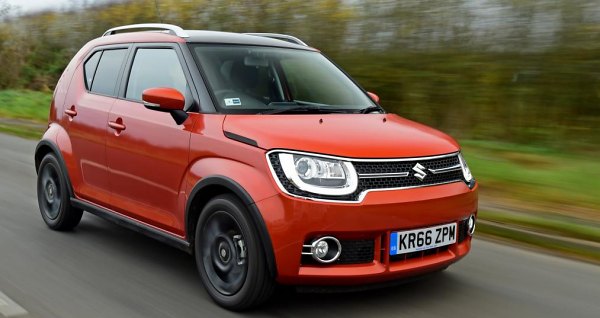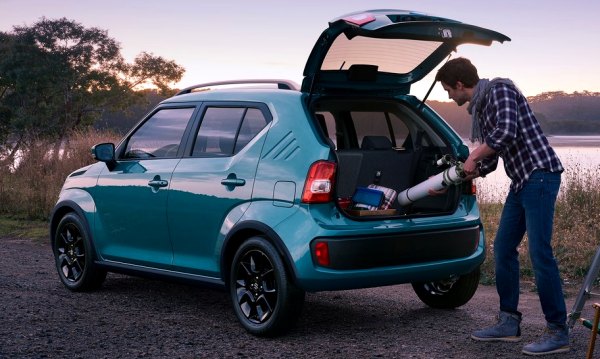Published
on 3
Jan 2017
|
All rights reserved.
|
|
|
 |
|
|
|
If
you wonder why I
am writing about a sub-compact SUV, read my review of Suzuki Hustler.
The same rationale applies to Ignis: while it looks like an SUV, it is
not much different from other Suzuki sub-compacts like Celerio. Yes, it
is a little bit taller and wider, but it is incredibly light – the base
model weighs only 810 kg, lighter than anything in its class, and it is
only 5 kg heavier than the lightest Smart Fortwo! The Ignis sits on the
lightweight platform of Baleno and the forthcoming Swift, and this is
the second reason why we should not see it as an SUV or crossover. Yes,
it does offer 4WD option, but so do most Japanese K-cars!
Like Hustler, the Ignis is likely to be a hot seller thanks to its SUV
pretension as well as its stylish exterior. Its front end looks pretty
upmarket. The blackened A-pillars and clamshell bonnet make it look
somewhat like a mini Land Rover. The flared wheel arches give further
visual clue to an offroader. The thick C-pillar with its triple-bar
recess is not inspired by Addidas logo but the 1971 Suzuki Cervo. Overall, the Ignis
looks funky yet special.
 |
|
|
|
Inside,
the funky design theme continues. There is a
two-tone dashboard and door panels, free-standing touchscreen and some
body-color-matching plastic trims to lift the ambience. On the
downside, the plastics are all hard and scratchy. The door slams with a
hollow sound. There are certainly some compromises to achieve that
lightweight, also because Suzuki is very cost-conscious. It lacks the
quality feel of not only European city cars but also most of its
Japanese and Korean rivals. Expectedly, the infotainment system is
basic thus unresponsive and not very good-looking. However, this cabin
gets the fundamentals right. The high driving position lets you have a
commanding view on the road. The steering wheel is well adjustable. The
cabin offers incredible space for the compact exterior. It has room for
4 average size adults. The boot is large enough at 267 liters.
Moreover, you can opt for a 50/50-splite sliding rear seat which can
adjust the allocation of rear legroom and luggage space. The rear bench
also folds flat to expand cargo space to a respectable 1100 liters. The
tailgate lifts high and opens wide to enable the easiest access to the
boot. For an entry-level city car, it has the most accommodation you
can dream of.
 |
|
|
|
Don’t expect
big-car refinement, of course. The Ignis sacrifices noise
insulation for lightweight, so it lets more tire, engine and wind noise
to ruin refinement when cruising on highway. It’s not as poor as many
last generation city cars though. The sole engine, the familiar 1.2
Dualjet four-cylinder with 90 horsepower is a willing motor. Coupling
to a slick 5-speed manual and a lightweight car, performance is pretty
good. 0-60 mph can be done in 11.5 seconds. It could be slightly
quicker still if you opt for the SHVS – abbreviation for the silly name
“Smart Hybrid Vehicle by Suzuki”, or simply “mild hybrid” in our words.
As in many Suzuki’s K-cars, it uses an integrated starter generator to
provide an additional 3 horsepower and recharge a small lithium battery
(which is packed under the front passenger seat) under braking. This
helps the car to get a NEDC emission rating of 97 g/km.
The car corners and rides okay rather than exceptional. The combination
of soft suspension and a tall body results in more roll in cornering
than a typical European city car, although that roll angle should be
familiar to the drivers of K-cars. The damping tuning is not very
sophisticated either. Sharp bumps can catch its suspension travel out,
while small irregularities on pavement are not sufficiently ironed out.
The steering is slow and vague. If you want more driving fun, you had
better to upgrade to a Swift, or turn to Volkswagen Up. The Ignis has
some strong appeals – mostly space, practicality, price and a funky
look – but dynamically it is unremarkable.
|
Verdict:    |
|